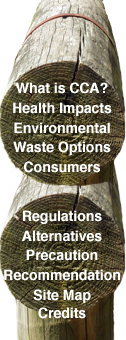Health Impacts
Industry Responses
The response by the timber preservation industry has been to deflect claims of hazard, with statements such as ‘CCA has been extensively used in Australia and New Zealand since the 1950’s. In all that time and with literally millions of users and people who have had contact with it to some extent, there have been very few if any validated adverse health affects associated with it when used as recommended with normal common sense handling precautions.…’ (Centre for Treated Timber Information, 2005).
Harry Greaves, chair of Timber Preservers Association of Australia’s technical committee, who previously worked for the CSIRO on CCA timber research, stated: ‘I don't believe the evidence that has been emerging in recent reviews is actually indicating that it's more hazardous than other particular dust-generating product’ (ABC, 2004). Osmose Australia, a timber-preserving company, maintains that ‘CCA-treated timber does not pose any significant health risk when used and handled correctly’, but has publicly agreed to comply with the APVMA’s recommendations, such as label variations (Osmose, 2004), aware that non-compliance will result in their products being prohibited from sale.
The website of the Centre for Treated Timber Information (2005) includes these ‘frequently asked questions’:
Q. Is treated timber harmful to the environment?
A. No
Q. Is CCA-treated timber safe for playground equipment, decking, patios, etc?
A. Yes…. If necessary a surface coating of paint or varnish may be applied to treated playground equipment, decking, etc. This provides protection from direct contact, if you are worried.
Koppers Arch refers to itself as ‘the leading name for wood protection in Australia, NZ, Fiji, Asia and South Africa’. When the US Consumer Product Safety Commission published its findings in 2003 that children playing on CCA treated timber had an increased risk of getting cancer (CPSC, 2003), Koppers Arch declared that the ‘wood preservation industry was taken aback.’ For years the wood preservative industry had referred to an earlier 1990 CPSC study that the industry had interpreted as approving of the use of CCA-treated timber for playground equipment even though it clearly found that children playing on CCA-treated equipment got arsenic on their hands. On its web page Koppers Arch states: ‘Our industry has often referred to that original study when defending CCA so it is particularly concerning that the CPSC has now apparently changed its position.’ (Koppers Arch 2003a).
Not to be put off by CPSC’s damning report, Koppers Arch now contends that CPSC is not ‘an expert authority in this type of epidemiological risk analysis’ even though it previously suited them to consider it as an expert authority. Koppers Arch also attempts to play down CPSC findings by claiming it only predicted ‘a slightly increased risk of certain cancers (lung and bladder cancers)’. However, paradoxically, Koppers Arch also attempts to dismiss the study by asserting ‘if the estimates of the risks from this level of arsenic exposure are anywhere near correct, then there should be epidemic levels of those cancers in the community as a result of this exposure.’ Since there aren’t, Koppers Arch concludes, CCA-treated timber must be safe (Koppers Arch 2003a).
Both Koppers Arch and the Timber Preservers Association of Australia (TPAA) maintain that CCA-treated timber is safe if it is handled correctly (Koppers Arch, 2003b; Greaves, 2003) but this is where they come unstuck, because CCA-treated timber does not come with instructions about how it should be handled. Nor do municipal or household installations made of treated timber.
Commerical play equipment manufacturers based outside Australia are influenced by international findings and public pressure. Kompan Playsets Australia builds commercial playground equipment for use in public areas, and does not use CCA-treated timber. The Danish company’s policy is ‘no hidden dangers’ and Denmark bans CCA-treated timber. Its choice of timber building materials must meet a number of European and US standards, which prohibit the use of CCA-treated timber for use in contact with children. Where timber is requested in the playsets, Kompan uses imported Baltic pine treated with copper-based Tanalith-E for small pieces, and untreated cypress pine for large structural pieces. Both materials are appropriate for in-ground use, and cypress pine is not used for small sections due to the tendency to warp and split.
The Kompan representative doubted whether treated timber was used for commercial playsets anymore but stated that ‘backyard cubby houses have a different brief, [manufacturers] can get away with using treated timber’ (Kompan, S, Kompan Playsets Australia, Pers. Comm., 15/11/04).
References:
ABC (2004), ‘AWU alert on CCA-treated timber’, ABC Country News Network, http://www.abc.net.au.
Centre for Treated Timber Information (2005), ‘Frequently Asked Questions’, Preserved Wood website, http://www.preservedwood.com.au/FAQ.php. Accessed 15/1/05.
CPSC (2003), Fact Sheet: Chromated Copper Arsenate (CCA) -Treated Wood Used in Playground Equipment, U.S. Consumer Product Safety Commission, February 7, http://www.cpsc.gov, (accessed 16/8/04)
Greaves, H. (2003), The Australian Timber Industry and CCA-Treated Timber Products, The Timber Preservers Association of Australia (TPAA), Moorabbin, Vic., 3 March. (pdf - 280kb)
Koppers Arch (2003a). ‘U.S. Consumer Product Safety Commission Report.’ Koppers Arch Wood Protection, http://www.tanalised.com/news.asp?content_id=101&id=12 (accessed 21/4/04).
Koppers Arch (2003b) ‘CCA and the Alternatives.’ Koppers Arch Wood Protection, http://www.tanalised.com/files/pdf/KACCA-Alt-Pos2003.pdf (accessed 21/4/04).
Osmose (2004), ‘APVMA Review of CCA’, Osmose News, August, http://www.osmose.com.au/News/CCAReview.html (accessed 22/11/04).


